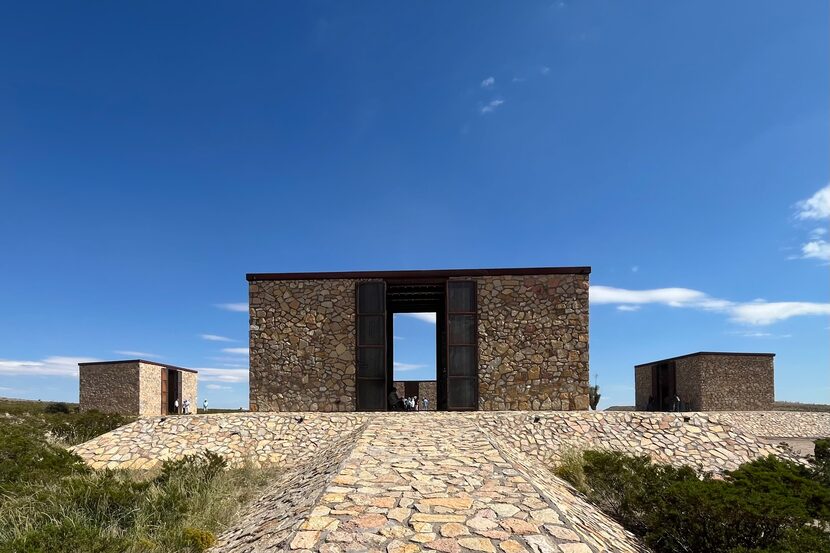Lifestyle
James Magee’s Hill: Preserving a Unique Artistic Legacy

The future of the Hill, a distinctive artwork in the Chihuahuan Desert created by the late artist James Magee, is currently under consideration by his heirs and local organizations. Located about 70 miles east of El Paso, Texas, this artistic landmark has been described as “the most important artwork most people have never heard of,” according to a writer for The New York Times. Magee dedicated nearly four decades to constructing the Hill, comprising four striking stone structures that evoke both ancient craftsmanship and modern abstraction.
Visiting the Hill is no simple task; it requires a deliberate journey through a remote landscape, including a mile-long trek along a dirt road that can wash out during rain. The site, featuring installations made from industrial materials such as crushed glass and steel parts, provides a unique blend of art and spirituality. Although Magee passed away in March 2022 at the age of 79, his work remains unfinished, leaving a complex legacy that requires careful consideration from those who wish to preserve it.
Exploring Magee’s Multifaceted Artistic Identity
Magee was not solely defined by the Hill. He expressed himself through multiple artistic personas: as a sculptor under his name, as Annabel Livermore, a painter of spiritually themed canvases, and as Horace Mayfield, an artist known for provocative writings. Jed Morse, a close friend and chief curator of the Nasher Sculpture Center, noted, “Jim wanted to do a lot artistically to speak to the incredible variety of the experience of life.” His diverse output has left his heirs grappling with how to manage and share his artistic legacy.
The Hill is not merely a monument to Magee’s creativity; it embodies his deep connection to the El Paso community. Friends and supporters, including Gary “Corky” Cunningham, an architect who consulted on the site, emphasize that the experience of the Hill is intrinsically linked to Magee himself. In the years leading up to his death, Magee debated the future of his work, at one point considering closing the Hill entirely. Ultimately, negotiations with friends and family led to a decision to keep it open to visitors but with restrictions on crowd size and photography.
Preserving the Hill and its Legacy
Magee’s life was as unconventional as his artistic endeavors. Born in rural Fremont, Michigan, he initially trained as a lawyer and worked for the United Nations in New York before pursuing a variety of roles, including welder and poet. After being stranded in El Paso due to a train derailment in the early 1980s, he fell in love with the region and made it his home. His philanthropic efforts included establishing a fund for fresh flowers at the University Medical Center of El Paso while battling health issues, including complications from HIV/AIDS that led to the amputation of both legs in the early 1990s.
In the years following his arrival in El Paso, Magee acquired land to create the Hill, a secluded space designed to showcase his work without interference from urban development. Over time, he constructed the four distinctive structures from native stone, employing techniques familiar to local laborers. Each building is positioned to align with the cardinal points of the compass, creating a layout reminiscent of a Greek cross.
Although Magee completed three of the structures, he left the fourth in a state of flux, with ambitious plans that included a mechanically adjustable glass floor. The challenge now lies in how to handle this unfinished space. Cunningham proposed a solution: covering the incomplete area with plywood that clearly distinguishes it from Magee’s work while preserving the essence of his vision.
The legacy of Magee’s artistry also extends to his workshop, a repurposed auto body shop filled with both completed and unfinished projects, as well as materials that fueled his creative process. Plans are underway to open this workshop to the public, maintaining sections as they were left while also presenting works from Magee and his other personas.
To sustain the Hill and its associated spaces, the El Paso Community Foundation, which oversees the Cornudas Mountain Foundation, is exploring funding strategies. This includes selling properties Magee acquired for his own use. Immediate plans involve constructing a new walking path to enhance visitor access and repairing the roof of El Museo Livermore, a small museum dedicated to Livermore’s work.
The annual funding requirement for maintaining the Hill and Magee’s other projects is approximately $500,000, a significant challenge, though the foundations currently cover 70% of this cost. “He left us with a legacy that we want to protect not only for El Paso to enjoy but for people around the world to experience,” said Eric Pearson, president of the El Paso Community Foundation. The dedication to preserving Magee’s unique vision ensures that his contributions to art and community will be appreciated for generations to come.
-

 Top Stories2 weeks ago
Top Stories2 weeks agoMarc Buoniconti’s Legacy: 40 Years Later, Lives Transformed
-

 Sports3 weeks ago
Sports3 weeks agoSteve Kerr Supports Jonathan Kuminga After Ejection in Preseason Game
-

 Entertainment3 weeks ago
Entertainment3 weeks agoZoe Saldana Advocates for James Cameron’s Avatar Documentary
-

 Business3 weeks ago
Business3 weeks agoTyler Technologies Set to Reveal Q3 2025 Earnings on October 22
-

 Science3 weeks ago
Science3 weeks agoChicago’s Viral ‘Rat Hole’ Likely Created by Squirrel, Study Reveals
-

 Politics3 weeks ago
Politics3 weeks agoDallin H. Oaks Assumes Leadership of Latter-day Saints Church
-

 Lifestyle3 weeks ago
Lifestyle3 weeks agoKelsea Ballerini Launches ‘Burn the Baggage’ Candle with Ranger Station
-

 Lifestyle3 weeks ago
Lifestyle3 weeks agoDua Lipa Celebrates Passing GCSE Spanish During World Tour
-

 Health3 weeks ago
Health3 weeks agoCommunity Unites for Seventh Annual Mental Health Awareness Walk
-

 World3 weeks ago
World3 weeks agoD’Angelo, Iconic R&B Singer, Dies at 51 After Cancer Battle
-

 Sports3 weeks ago
Sports3 weeks agoPatriots Dominate Picks as Raiders Fall in Season Opener
-

 Health3 weeks ago
Health3 weeks agoRichard Feldman Urges Ban on Menthol in Cigarettes and Vapes









